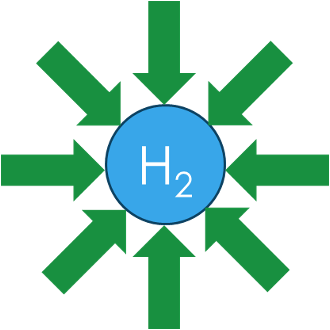H2 Compression
 Based on the Nernst equation and the redoxpotential of hydrogen being 0V, hydrogen can be seperated into protons and electrons. Whilst the electrons are being transported through an external circuit, protons diffuse through Proton Technologies unique membrane and are recombined with electrons at the end of the membrane forming hydrogen. When this hydrogen is formed in a container the pressure will rise according to Nernst up to an equilibrium where the potential meets the concentration difference of Nernst. As the membrane itself is nearly impermeable for gas molecules, the hydrogen will not easily diffuse through resulting in pressure differences capable of exceeding 700bar. Since the compression type is isothermal (no moving parts), the amount of energy required is significantly less than mechanical compression.
Based on the Nernst equation and the redoxpotential of hydrogen being 0V, hydrogen can be seperated into protons and electrons. Whilst the electrons are being transported through an external circuit, protons diffuse through Proton Technologies unique membrane and are recombined with electrons at the end of the membrane forming hydrogen. When this hydrogen is formed in a container the pressure will rise according to Nernst up to an equilibrium where the potential meets the concentration difference of Nernst. As the membrane itself is nearly impermeable for gas molecules, the hydrogen will not easily diffuse through resulting in pressure differences capable of exceeding 700bar. Since the compression type is isothermal (no moving parts), the amount of energy required is significantly less than mechanical compression.
Possible applications:
- Vehicle refuelling
- Small urban vehicles
- Cars
- Buses
- Trucks
- Ships
- Aircrafts
- Gas cylinder filling
- Drone refueling
